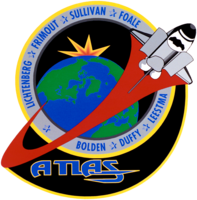STS-45
 | |
| Dane misji | |
| Indeks COSPAR | 1992-015A |
|---|---|
| Zaangażowani | |
| Oznaczenie kodowe | STS-45 |
| Pojazd | |
| Wahadłowiec | Atlantis |
| Załoga | |
 Siedzą od lewej: Brian Duffy, Charles F. Bolden Jr. Stoją od lewej: Byron Lichtenberg, Michael Foale, David Leestma, Kathryn Sullivan, Dirk Frimout | |
| Dowódca | Charles Bolden |
| Start | |
| Miejsce startu | Stany Zjednoczone, KSC, LC39-A |
| Początek misji | 24 marca 1992 13:13:40 UTC |
| Orbita okołoziemska | |
| Apogeum | 294 km |
| Perygeum | 282 km |
| Okres orbitalny | 90,3 min |
| Inklinacja orbity | 57,0° |
| Lądowanie | |
| Miejsce lądowania | KSC, Pas startowy 33 |
| Lądowanie | 2 kwietnia 1992 11:23:05 UTC |
| Czas trwania misji | 8 dni, 22 godz, 9 min, 25 sek |
| Przebyta odległość | 5 994 719 km[1] |
| Liczba okrążeń Ziemi | 143[1] |
| Program lotów wahadłowców | |
STS-45 (ang. Space Transportation System) – jedenasta misja wahadłowca kosmicznego Atlantis i czterdziesta szósta programu lotów wahadłowców[2].
Załoga
- Charles Bolden, (3)*, dowódca (CDR)
- Brian Duffy (1), pilot (PLT)
- Kathryn Sullivan (3), dowódca ładunku (MS1)
- David Leestma (3), specjalista misji 2 (MS2)
- Michael Foale (1), specjalista misji 3 (MS3)
- Byron Lichtenberg (2), specjalista ładunku 2 (PS2)
- Dirk Frimout (1), specjalista ładunku 1 (PS1) (Belgia)
- *(liczba w nawiasie oznacza liczbę lotów odbytych przez każdego z astronautów)
Parametry misji
źródło dla sekcji: [1]
- Masa:
- startowa orbitera: 105 981 kg
- lądującego orbitera: 93 003 kg
- ładunku: 8020 kg
- Perygeum: 282 km
- Apogeum: 294 km
- Inklinacja: 57,0°
- Okres orbitalny: 90,3 min
Cel lotu
Lot poświęcony badaniu atmosfery ziemskiej przy pomocy zestawu aparatury ATLAS-01 umieszczonego w laboratorium Spacelab w ładowni orbitera[2].
Zobacz też
Przypisy
- ↑ a b c Mark Wade: STS-40 (ang.). W: Encyclopedia Astronautica [on-line]. [dostęp 2017-07-25].
- ↑ a b c Tomáš Přibyl: Dzień, w którym nie wróciła COLUMBIA. Bielsko-Biała: Wydawnictwo >DEBIT<, 2003, s. 166.
- ↑ Robert Godwin: Space Shuttle. Warszawa: Prószyński Media Sp. z o.o., 2011, s. 65, seria: Historia podboju Kosmosu. ISBN 978-83-7648-973-5.
Linki zewnętrzne
- podsumowanie misji STS-45 na stronie NASA (ang.)
- Mark Wade: STS-45 (ang.). W: Encyclopedia Astronautica [on-line]. [dostęp 2017-07-25].
- Spaceflight mission report: STS-45 (ang.). Space Facts. [dostęp 2014-06-03].
Media użyte na tej stronie
The flag of Navassa Island is simply the United States flag. It does not have a "local" flag or "unofficial" flag; it is an uninhabited island. The version with a profile view was based on Flags of the World and as a fictional design has no status warranting a place on any Wiki. It was made up by a random person with no connection to the island, it has never flown on the island, and it has never received any sort of recognition or validation by any authority. The person quoted on that page has no authority to bestow a flag, "unofficial" or otherwise, on the island.
STS-45 Mission Insignia
The STS-45 mission official crew portrait includes Brian Duffy, pilot (seated on left); and Charles F. Bolden, Jr., commander (seated on right). Standing on the back row (left to right) are Byron K. Lichtenberg, payload specialist 1; C. Michael Foale, mission specialist 3; David C. Leestma, mission specialist 2; Kathryn D. Sullivan, payload commander; and Dirk D. Frimout, payload specialist 2. The primary payload for the mission was the Atmospheric Laboratory for Applications and Science-1 (ATLAS-1). The mission launched aboard the Space Shuttle Atlantis on March 24, 1992 at 8:13:40am (EST).


